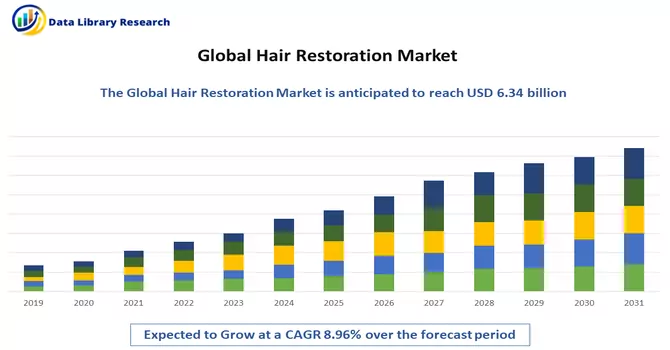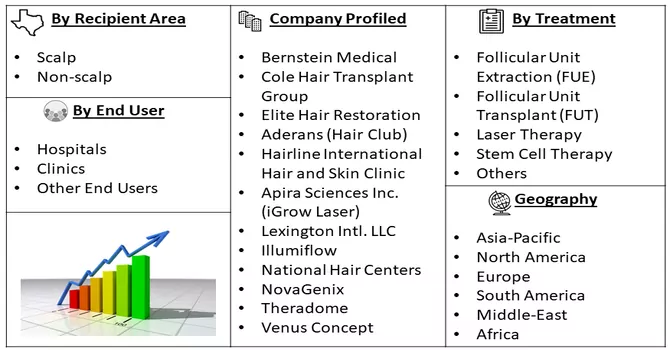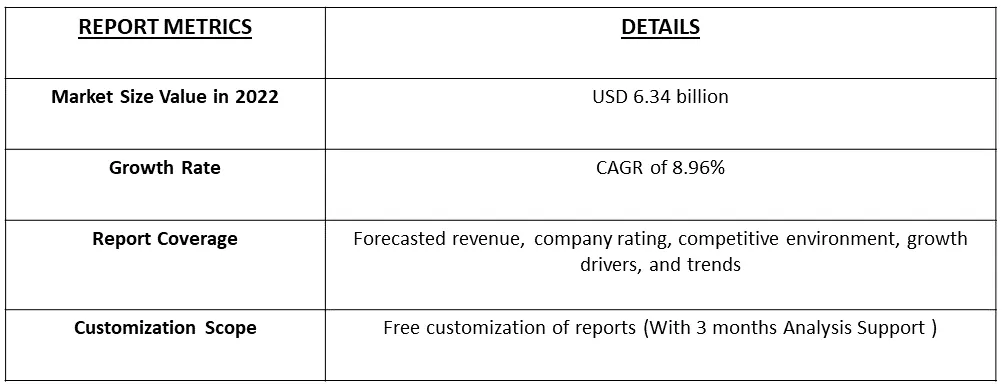The Hair Restoration Market size is currently valued at USD 6.34 billion in 2022 and is expected to register a CAGR of 8.96% during the forecast period (2023-2030).

Get Complete Analysis Of The Report - Download Free Sample PDF
Hair restoration is a medical procedure that involves the relocation of hair from the permanent hair-rich areas at the back and sides of the scalp, known as the donor area, to regions on the front, top, or crown of the scalp where hair thinning or baldness has occurred, known as the recipient area. Once successfully transplanted, the hair is expected to grow naturally. The growth of the hair restoration market is primarily driven by the rising demand for hair transplant procedures and the increasing incidence of diverse dermatological conditions that result in hair loss
One of the most notable trends in the hair restoration market is the rise of non-invasive procedures. Patients are increasingly seeking non-surgical options, such as platelet-rich plasma (PRP) therapy and low-level laser therapy (LLLT). These approaches promise less downtime, reduced discomfort, and a more natural-looking outcome. Robotics and artificial intelligence are increasingly being integrated into hair transplant procedures. Robotic systems can assist surgeons in precise follicle extraction and transplantation, improving the accuracy and efficiency of the process. Thus, these market trends are contributing to the growth of the studied market over the forecast period.
Market Segmentation: The Hair Restoration Services Market is Segmented by Recipient Area (Scalp and Non-scalp), Treatment (Follicular Unit Extraction (FUE), Follicular Unit Transplant (FUT), Laser Therapy, Stem Cell Therapy, and Other Treatments), End User (Hospitals, Clinics, and Other End Users), and Geography (North America, Europe, Asia-Pacific, Middle East and Africa, and South America). The report offers the market size in value terms in USD for all the abovementioned segments.

For Detailed Market Segmentation - Download Free Sample PDF
Market Drivers:
Increasing Popularity of Hair Restoration
Hair restoration has become an increasingly popular option for individuals seeking to address hair loss and rejuvenate their appearance. In recent years, the demand for hair restoration procedures and treatments has seen remarkable growth. Modern hair restoration clinics prioritize individualized treatment plans. Customization allows patients to address their unique concerns, whether it's frontal hairline restoration, thicker crown coverage, or filling in receding temples. This tailored approach has boosted patient satisfaction.
Moreover, as per a research study released by NCBI in April 2022, the current-year prevalence of alopecia areata stands at 0.2%, and it is a condition that can affect individuals of any racial or sexual orientation background, making it a widespread concern. On the other hand, androgenetic alopecia impacts 15% of women and a significant 50% of men, with postmenopausal women being particularly susceptible. The escalating number of chemotherapy treatments administered globally for cancer management, coupled with the growing burden of cancer cases, is anticipated to drive an upsurge in the demand for hair restoration procedures. Thus, such factors are contributing to the growth of the studied market.
Increasing Prevalence of Various Forms of Dermatological Disorders Leading to Hair Loss
Alopecia areata is an autoimmune disorder that causes hair loss in distinct, round patches. Its prevalence has been on the rise, affecting individuals of all ages, genders, and ethnic backgrounds. Stress and genetics are among the factors associated with alopecia areata. Androgenetic alopecia, also known as pattern baldness, is increasingly common, affecting both men and women. Genetic predisposition, hormonal imbalances, and age contribute to the development of this disorder. The hair transplant market is poised for substantial growth, driven by remarkable technological advancements in hair transplant devices and the introduction of innovative services worldwide. An exemplar of this trend is the April 2022 launch of a cost-effective and distinctive follicular unit extraction (FUE) method service for hair transplants in Turkey by HHC (Hermest Hair Clinic). These progressive developments are anticipated to be key factors propelling market expansion in the foreseeable future.
Market Restraints:
High Post-surgery Care along with Adverse Side Effects
While modern techniques, like Follicular Unit Extraction (FUE), minimize scarring, some patients may still experience noticeable scarring at the donor site. Some patients report temporary numbness or increased sensitivity in the donor and recipient areas following the procedure. Despite meticulous planning, the final outcome of a hair transplant can be somewhat unpredictable, leading to potential dissatisfaction among some patients. Thus, these factors ,may slow down the growth of the studied market over the forecast period.
The hair restoration market experienced adverse effects due to the COVID-19 pandemic, primarily driven by the widespread cancellation of cosmetic procedures, including hair restoration treatments. Nevertheless, with the gradual easing of restrictions, hair transplant clinics have reopened and resumed their operations. The adoption of telemedicine and virtual consultations played a crucial role in enabling hair transplant clinics to continue delivering their services to patients remotely, mitigating the pandemic's impact on their operations. The pandemic underscored the significance of personal appearance and grooming, as many individuals spent more time at home and engaged in video calls for work and social interactions. Consequently, there has been a noticeable surge in the demand for hair restoration procedures, particularly hair transplant surgeries, as individuals sought to enhance their appearance and confidence. The hair restoration market experienced adverse effects due to the COVID-19 pandemic, primarily driven by the widespread cancellation of cosmetic procedures, including hair restoration treatments. Nevertheless, with the gradual easing of restrictions, hair transplant clinics have reopened and resumed their operations. The adoption of telemedicine and virtual consultations played a crucial role in enabling hair transplant clinics to continue delivering their services to patients remotely, mitigating the pandemic's impact on their operations. The pandemic underscored the significance of personal appearance and grooming, as many individuals spent more time at home and engaged in video calls for work and social interactions. Consequently, there has been a noticeable surge in the demand for hair restoration procedures, particularly hair transplant surgeries, as individuals sought to enhance their appearance and confidence.
Segmental Analysis :
Scalp Segment is Expected to Witness Significant Growth Over the Forecast Period
Scalp and hair transplantation has emerged as a revolutionary solution for individuals grappling with hair loss or seeking to rejuvenate their appearance. This intricate and precise procedure involves the transplantation of hair follicles from one area of the scalp to another, ultimately restoring natural hair growth. This traditional method involves the removal of a strip of skin from the donor area, typically the back of the scalp, and dissecting it into individual follicular units for transplantation. It leaves a linear scar. This non-surgical procedure involves the application of specialized pigments to create the illusion of a fuller head of hair. It is an appealing option for individuals who may not be suitable candidates for surgical transplantation. Thus, owing to such advantages the segment is expected to witness significant growth over the forecast period.
Follicular Unit Extraction (FUE) Segment is Expected to Witness Significant Growth Over the Forecast Period
Follicular Unit Extraction (FUE) is a groundbreaking and minimally invasive hair transplantation technique that has gained widespread popularity in the field of hair restoration. This procedure offers an advanced alternative to traditional hair transplantation methods and has significantly improved patient experiences. FUE involves the extraction of individual hair follicles from the donor area, typically located at the back of the scalp, and their precise transplantation into the recipient area, where hair loss or thinning is evident. FUE is known for leaving minimal scarring, making it an attractive option for those who prefer shorter haircuts or want to avoid visible scars. The minimally invasive nature of FUE results in a faster recovery compared to traditional methods like Follicular Unit Transplantation (FUT), where a strip of skin is removed. Thus, owing to such advantages, the segment is expected to witness significant growth over the forecast period.
Hospitals Segment is Expected to Witness Significant Growth Over the Forecast Period
Hospitals, traditionally associated with critical medical care, have expanded their scope of services to include a surprising and transformative niche: hair transplantation services. While hair transplants were once exclusively the domain of specialized clinics, hospitals have recognized the growing demand for these procedures and are now offering comprehensive hair restoration solutions. Hospitals have access to a wide range of medical specialists, including dermatologists and plastic surgeons who are well-versed in the intricacies of hair transplantation procedures. This expertise ensures that patients receive top-tier care from trained professionals. Moreover, hospitals can offer patients a thorough evaluation of their hair loss condition, including any underlying medical factors. This holistic approach allows for personalized treatment plans and the identification of potential health-related causes of hair loss. Thu, the segment is expected to witness significant growth over the forecast period.
North America is Expected to Witness Significant Growth Over the Forecast Period
North America is poised to capture a significant share of the hair restoration market, driven by its large target population and the presence of technologically advanced clinics. Notably, in 2021, Canada and the United States witnessed 149,254 hair transplants, although this marked a 22% decline from the previous year due to COVID-19-related restrictions. However, with the easing of these restrictions, the number of hair transplants is projected to surge in the current year, consequently propelling the growth of the hair restoration market in the forecast period. The region's growing number of hair transplant surgeries and the presence of numerous market players have led to increased product launches and expansions within the market. For instance, Stemson Therapeutics secured USD 15 million in Series A financing, led by DCVC Bio in July 2021, aimed at advancing the development of Stemson's proprietary therapeutic solution for curing hair loss. This funding is expected to foster technological advancements in hair restoration products and services, further driving demand in the North American market during the forecast period.

Get Complete Analysis Of The Report - Download Free Sample PDF
The hair restoration market is fragmented in nature due to the presence of many companies operating globally as well as regionally. The competitive landscape includes an analysis of a few international as well as local companies that hold market shares and are well known. Some key players are:
Recent Developments:
1) In February 2023, HairClub, expanded its facility in Florida, United States, for residents seeking hair loss solutions.
2) In April 2022, HermestHair Clinic (HHC) launched cost-effective and unique follicular unit extraction (FUE) method service for hair transplants in Turkey.
Q1. What is the current Hair Restoration Market size?
The Hair Restoration Market size is currently valued at USD 6.34 billion.
Q2. What is the Growth Rate of the Hair Restoration Market?
Hair Restoration Market is expected to register a CAGR of 8.96% during the forecast period.
Q3. What are the factors driving the Hair Restoration Market?
Key factors that are driving the growth include the Increasing Popularity of Hair Restoration and Increasing Prevalence of Various Forms of Dermatological Disorders Leading to Hair Loss.
Q4. Who are the key players in Hair Restoration Market?
Some key players operating in the market include
Data Library Research are conducted by industry experts who offer insight on industry structure, market segmentations technology assessment and competitive landscape (CL), and penetration, as well as on emerging trends. Their analysis is based on primary interviews (~ 80%) and secondary research (~ 20%) as well as years of professional expertise in their respective industries. Adding to this, by analysing historical trends and current market positions, our analysts predict where the market will be headed for the next five years. Furthermore, the varying trends of segment & categories geographically presented are also studied and the estimated based on the primary & secondary research.
In this particular report from the supply side Data Library Research has conducted primary surveys (interviews) with the key level executives (VP, CEO’s, Marketing Director, Business Development Manager and SOFT) of the companies that active & prominent as well as the midsized organization
FIGURE 1: DLR RESEARH PROCESS

Extensive primary research was conducted to gain a deeper insight of the market and industry performance. The analysis is based on both primary and secondary research as well as years of professional expertise in the respective industries.
In addition to analysing current and historical trends, our analysts predict where the market is headed over the next five years.
It varies by segment for these categories geographically presented in the list of market tables. Speaking about this particular report we have conducted primary surveys (interviews) with the key level executives (VP, CEO’s, Marketing Director, Business Development Manager and many more) of the major players active in the market.
Secondary ResearchSecondary research was mainly used to collect and identify information useful for the extensive, technical, market-oriented, and Friend’s study of the Global Extra Neutral Alcohol. It was also used to obtain key information about major players, market classification and segmentation according to the industry trends, geographical markets, and developments related to the market and technology perspectives. For this study, analysts have gathered information from various credible sources, such as annual reports, sec filings, journals, white papers, SOFT presentations, and company web sites.
Market Size EstimationBoth, top-down and bottom-up approaches were used to estimate and validate the size of the Global market and to estimate the size of various other dependent submarkets in the overall Extra Neutral Alcohol. The key players in the market were identified through secondary research and their market contributions in the respective geographies were determined through primary and secondary research.
Forecast Model
